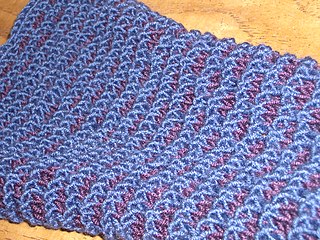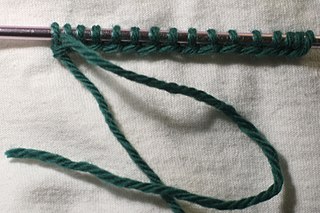
Knitting is a method for production of textile fabrics by interlacing yarn loops with loops of the same or other yarns. It is used to create many types of garments. Knitting may be done by hand or by machine.

A knitting needle or knitting pin is a tool in hand-knitting to produce knitted fabrics. They generally have a long shaft and taper at their end, but they are not nearly as sharp as sewing needles. Their purpose is two-fold. The long shaft holds the active (unsecured) stitches of the fabric, to prevent them from unravelling, whereas the tapered ends are used to form new stitches. Most commonly, a new stitch is formed by inserting the tapered end through an active stitch, catching a loop of fresh yarn and drawing it through the stitch; this secures the initial stitch and forms a new active stitch in its place. In specialized forms of knitting the needle may be passed between active stitches being held on another needle, or indeed between/through inactive stitches that have been knit previously.
Intarsia is a knitting technique used to create patterns with multiple colours. As with the woodworking technique of the same name, fields of different colours and materials appear to be inlaid in one another, fit together like a jigsaw puzzle.
English knitting, also known as right-hand knitting or throwing, is a style of Western knitting where the yarn to be knit into the fabric is carried in the right hand. This style is prevalent throughout the English-speaking world, though it is by no means universal.
The term "gauge" is used in knitting to describe the fineness size of knitting machines. It is used in both hand knitting and machine knitting. The phrase in both instances refers to the number of stitches per inch rather than the size of the finished article of clothing. The gauge is calculated by counting the stitches or needles across a number of inches, then dividing by the sample's width in inches.

A knitting machine is a device used to create knitted fabrics in a semi or fully automated fashion. There are numerous types of knitting machines, ranging from simple spool or board templates with no moving parts to highly complex mechanisms controlled by electronics. All, however, produce various types of knitted fabrics, usually either flat or tubular, and of varying degrees of complexity. Pattern stitches can be selected by hand manipulation of the needles, push-buttons and dials, mechanical punch cards, or electronic pattern reading devices and computers.

A decrease in knitting is a reduction in the number of stitches, usually accomplished by suspending the stitch to be decreased from another existing stitch or by knitting it together with another stitch.

Slip-stitch knitting is a family of knitting techniques that uses slip stitches to make multiple fabrics simultaneously, to make extra-long stitches, and/or to carry over colors from an earlier row.

In knitting, an increase is the creation of one or more new stitches, which may be done by various methods that create distinctive effects in the fabric. Most knitting increases either lean towards the left or the right.

In knitting, casting on is a family of techniques for adding new stitches that do not depend on earlier stitches, i.e., having an independent lower edge. In principle, it is the opposite of binding off, but the techniques involved are generally unrelated.
Knitting abbreviations are often used for brevity in describing knitting patterns.

In knitting, a short row is a row that is not fully knitted; the work is turned before reaching the end of the row. When working short rows, technique must be employed to prevent holes or gaps where the work is turned. There are several ways to do this. Among the most common are (1) Wrap and Turn, (2) German short rows and (3) Japanese short rows.

In knitting, picking up stitches means adding stitches to the knitting needle that were previously bound off or belong to the selvage.
In knitting, buttonholes can be made in several ways.

Knitted fabric is a textile that results from knitting, the process of inter-looping of yarns or inter-meshing of loops. Its properties are distinct from woven fabric in that it is more flexible and can be more readily constructed into smaller pieces, making it ideal for socks and hats.
Hand knitting is a form of knitting, in which the knitted fabric is produced by hand using needles.

Cowichan knitting is a form of knitting characteristic of the Cowichan people of southeastern Vancouver Island, British Columbia. The distinctively patterned, heavy-knit Cowichan sweaters, popular among British Columbians and tourists, are produced using this method. Cowichan knitting is an acculturated art form, a combination of European textile techniques and Salish spinning and weaving methods. From this union, new tools, techniques and designs developed over the years.
In knitting, the three needle bindoff is a method of joining two pieces of knitted fabric using three needles. One needle is on each piece of the fabric, and a third needle is used for the knitting.
Arm knitting is a knitting technique which uses the knitter's arms instead of knitting needles. This method of knitting gained popularity during 2013 and 2014.

Twined knitting is a traditional Scandinavian knitting technique. It refers to knitting where two strands of yarn are knitted into the fabric alternatively and twisted once and always in the same direction before every stitch. The technique is called tvåändsstickning in Swedish, tvebandsstrikking in Norwegian, and tvebinding in Danish. Their literal meaning is "two-end knitting", referring to the traditional way of knitting with both yarn ends from one ball of yarn.












